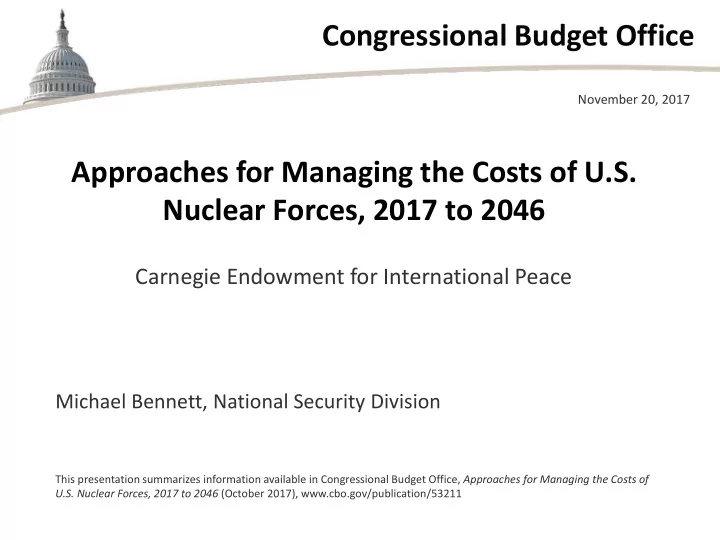

Congressional Budget Office November 20, 2017 Approaches for Managing the Costs of U.S. Nuclear Forces, 2017 to 2046 Carnegie Endowment for International Peace Michael Bennett, National Security Division This presentation summarizes information available in Congressional Budget Office, Approaches for Managing the Costs of U.S. Nuclear Forces, 2017 to 2046 (October 2017), www.cbo.gov/publication/53211
Task and Approach ■ CBO was asked to – Estimate the costs of plans to develop, sustain, and field existing and future nuclear forces – Analyze approaches to manage costs by adjusting modernization plans ■ Estimates for the report are based on 2017 budget plans – Used the same methodology that CBO used for biannual 10-year cost estimates (with several important exceptions) – Projected DoD’s and DOE’s existing plans out to 2046, including average cost growth experienced historically for similar programs – Performed independent estimates of major modernization programs using parametric models based on historical data or actual costs of similar programs 2 CONGRESSIONAL BUDGET OFFICE
Projected Costs of U.S. Nuclear Forces, 2017 to 2046 3 CONGRESSIONAL BUDGET OFFICE
Differences Between CBO’s 30-year and 10-year Cost Estimates ■ Different time scale – 30-year time scale to capture full modernization cycle ■ Constant dollars instead of nominal dollars – Inflation can distort analysis over longer periods ■ Different allocation of bomber costs – Current study used 100 percent of B-2, B-52, and B-21 costs because some options delayed or reduced the size of the B-21 fleet – Current study noted costs (and savings) if one used 25 percent of B-52 and B-21 costs, as in the 10-year estimates 4 CONGRESSIONAL BUDGET OFFICE
Annual Costs of Nuclear Forces, 2017 to 2046 5 CONGRESSIONAL BUDGET OFFICE
Approximate Modernization Timelines * = program continues beyond 2046 6 CONGRESSIONAL BUDGET OFFICE
Options That Would Reduce the Costs of Nuclear Forces ■ CBO developed nine options based on three general approaches – Delay some modernization programs (one option) – Reduce force structure but keep warheads at New START levels (five options) – Reduce force structure and the number of warheads (three options) ■ For each option, CBO – Estimated savings relative to costs of planned forces • If implemented for the next generation of systems • If implemented for the current generation of systems – Assessed the impact on capability relative to that of planned forces • Number of warheads in three categories • Characteristics under three scenarios (crisis management, limited nuclear strike, large-scale nuclear exchange) 7 CONGRESSIONAL BUDGET OFFICE
One Option that would Delay Some Modernization Programs 8 CONGRESSIONAL BUDGET OFFICE
Five Options that Would Reduce Force Structure but Keep 1,550 Warheads Source: Congressional Budget Office using information from the Department of Defense and the Department of Energy. 9 CONGRESSIONAL BUDGET OFFICE
Effects on Capability for Options at 1,550 Warheads Source: Congressional Budget Office. 10 CONGRESSIONAL BUDGET OFFICE
Three Options that Would Reduce Force Structure and Decrease Warheads to 1,000 Source: Congressional Budget Office using information from the Department of Defense and the Department of Energy. 11 CONGRESSIONAL BUDGET OFFICE
Effects on Capability for Options at 1,000 Warheads Source: Congressional Budget Office. 12 CONGRESSIONAL BUDGET OFFICE
Total Costs of CBO’s Force Structure Options 13 CONGRESSIONAL BUDGET OFFICE
Recommend
More recommend